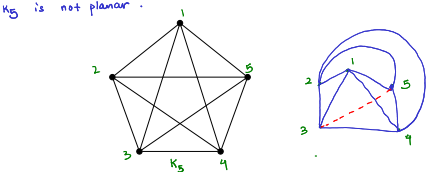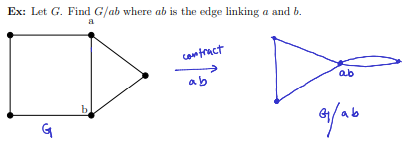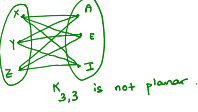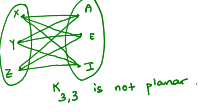Graph Theory Cont'd
1/21
There's no tags or description
Looks like no tags are added yet.
Name | Mastery | Learn | Test | Matching | Spaced |
|---|
No study sessions yet.
22 Terms
defn of a bipartite graph
A graph G is bipartite when their vertex set can be divided into two disjoint sets U and V such that no two vertices within the same set are adjacent.
no vertices in set U are adjacent in the orig graph and same goes for set V
vertices in set U are adjacent to vertices in set V
a graph G is bipartite if and only if ___
none of the subgraphs of G are isomorphic to a cycle of odd length.
no odd cycle (C1, C3, C5.. etc) is bipartite
ALL even cycles are bipartite
any graph that HAS AN ODD CYCLE AS A SUBGRAPH is NOT bipartite
defn of a planar graph
A graph G is planar if it can be drawn on the plane without any intersecting edges. Such a drawing is called a planar embedding of G.
example of a planar graph and a planar embedding of a graph

example of a non-planar graph

defn of “contract”
to contract an edge e of a graph G is to remove e, and fuse together the vertices incident to e.
the resulting graph is denoted G/e.
visual of contracting an edge

if G is planar and v is a vertex of G, then G - v is ____
planar
G - v means to delete the vertex v AND ALL edges incident to it
If G is planar and ab is an edge of G, then G - ab is ______
planar
G - ab means to remove the edge ab (not contracting it)
If G is planar and ab is an edge of G, then G/ab is _______
planar
G/ab means to contract the edge ab
A graph G is not planar if and only if:
K5 or K3,3 can be obtained from G via a sequence of vertex deletions, edge deletions and edge contractions.
K3,3

K5

defn of “colouring a graph”
let G be a graph. A colouring of G is a way of assigning a colour to every vertex of G such that any two adjacent vertices receive different colours.
the min num of colours needed to colour G (and satisfy the above stipulation) is the CHROMATIC number of G
chromatic number
the minimum number of colours needed to colour G is the chromatic number of G, denoted by χ(G).
how to obtain the chromatic number of a graph G
a colouring of G = (V, E) (which is (# of vertices, # of edges)) with n colours is a function f : V (set of vertices in G) → {1, 2, ..., n} (set of natural numbers up to n) such that if a is adjacent to b, then f(a) ̸= f(b) (they don’t share the same colour)
the set of natural numbers are the numbers assigned to distinct colours (ex: 1 = red)
if H is a subgraph of G, then
χ(H) ≤ χ(G). (the # of colours needed to colour H is less than the # of colours needed to colour G)
Any colouring of G with χ(G) colours generates a colouring of H with at most χ(G) colours.
χ(Kn) =
n
χ(Cn) = ___ if n is ____, and χ(Cn) = ___ if n is ____
2; even; 3; odd
method to colour a graph (2 steps)
Sort the vertices of G in an arbitrary order v1, v2, v3, ..., vn.
Colour the vertices of G, one by one, in the given order, by assigning to vi the smallest possible colour (colour 1, for example) at each step
let G = (V,E) be a graph, and let ∆ = max{deg(v) | v ∈ V}, then
χ(G) ≤ ∆ + 1
meaning the chromatic num of the graph <= biggest deg + 1
chromatic poly
→ gives the ways to colour a graph with [symbol] colours in a formula
![<p>→ gives the ways to colour a graph with [symbol] colours in a formula</p>](https://knowt-user-attachments.s3.amazonaws.com/60d2b0ea-dc8c-48c4-9086-f495b969042c.png)